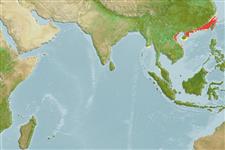Common names from other countries
分類 / Names
共通名の | 類義語 | Catalog of Fishes(部類, 種) | ITIS | CoL | WoRMS | Cloffa
>
Clupeiformes (Herrings) >
Dorosomatidae (Gizzard shads and sardinellas)
Etymology: Tenualosa: Latin, tenuis = thin + Latin, alausa = a fish cited by Ausonius and Latin, halec = pickle, dealing with the Greek word hals = salt; it is also the old Saxon name for shad = "alli" ; 1591 (Ref. 45335).
More on author: Richardson.
Environment: milieu / climate zone / depth range / distribution range
生態学
海; 新鮮な水; 汽水性の; 昇流魚 (Ref. 51243); 深さの範囲 0 - 50 m (Ref. 188). Tropical; 31°N - 5°N, 95°E - 123°E (Ref. 188)
Northwest Pacific: China and possibly southward into South China Sea, but records uncertain. Eastern Indian Ocean: two specimens collected from Phuket Island, Andaman Sea. The species thus overlaps Tenualosa toli in range.
Length at first maturity / サイズ / 重さ / 年齢
Maturity: Lm 47.5, range 44 - 51 cm
Max length : 61.6 cm TL オス/雌雄の選別がない; (Ref. 45563); common length : 40.0 cm TL オス/雌雄の選別がない; (Ref. 27773); 最大公表体重: 5.0 kg (Ref. 47439); 最大記録サイズ: 8 年 (Ref. 45563)
背面の脊椎 (合計) : 3; 背鰭 (合計) : 14 - 15; 肛門の骨: 2; 臀鰭: 16 - 18; 脊つい: 44 - 45. Belly with 29 to 34 scutes. Head large; a median notch in upper jaw, which distinguishes it from other similar clupeids, except Hilsa kelee; with a well developed sebaceous eyelids. Gill rakers fine and numerous, each raker with scattered asperities. Caudal fin deeply forked with minute scales. A dark blotch behind gill opening and a series of spots along flank. Color: Metallic blue-green back that lightens to silver along the sides (Ref. 45563).
Schooling in coastal waters and ascending rivers to breed. Adults are found near the surface at sea while larvae and juveniles spend the first two years of their life in river tide pools and estuaries (Ref. 57990). Feed on planktonic crustaceans like cyclopoids and other copepods, and rotifers (Ref. 45563).
Ascend rivers to breed (Ref. 45563). After spawning, the adults go back to the sea while the larvae stay in river mouths during their first year. At the beginning of their second year, the juveniles swim to the sea (Ref. 45563).
Whitehead, P.J.P., 1985. FAO Species Catalogue. Vol. 7. Clupeoid fishes of the world (suborder Clupeoidei). An annotated and illustrated catalogue of the herrings, sardines, pilchards, sprats, shads, anchovies and wolf-herrings. FAO Fish. Synop. 125(7/1):1-303. Rome: FAO. (Ref. 188)
CITES (Ref. 128078)
Not Evaluated
Human uses
水産業: 少数商業の
用具
特記事項
XMLをダウンロードして下さい
インターネットの情報源
Estimates based on models
Preferred temperature (Ref.
115969): 22.8 - 26.6, mean 25.2 (based on 90 cells).
Phylogenetic diversity index (Ref.
82804): PD
50 = 0.5312 [Uniqueness, from 0.5 = low to 2.0 = high].
Bayesian length-weight: a=0.01122 (0.00689 - 0.01827), b=3.04 (2.90 - 3.18), in cm Total Length, based on LWR estimates for this species & (Sub)family-body (Ref.
93245).
栄養段階 (Ref.
69278): 3.2 ±0.29 se; based on food items.
回復力 (Ref.
120179): 手段, 1.4年~4.4年の倍増期間の最小個体群 (tm=3; tmax=8; K=0.25-0.29; Fec = 1,070,000).
Fishing Vulnerability (Ref.
59153): Low to moderate vulnerability (34 of 100).
